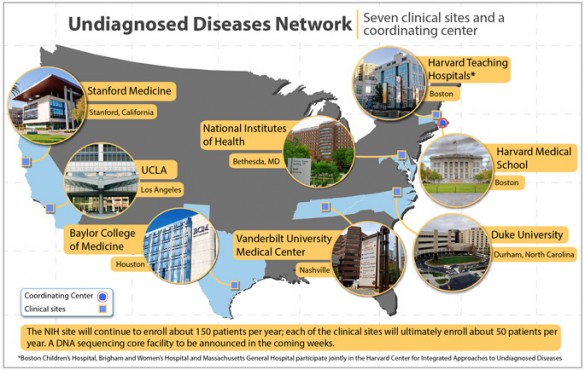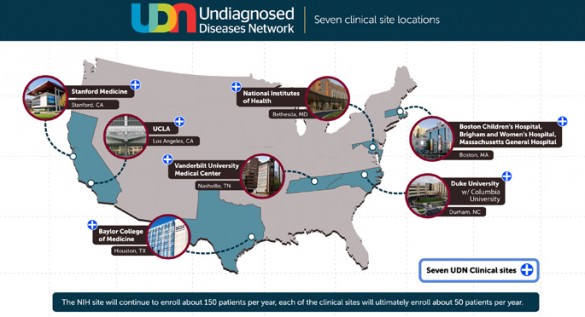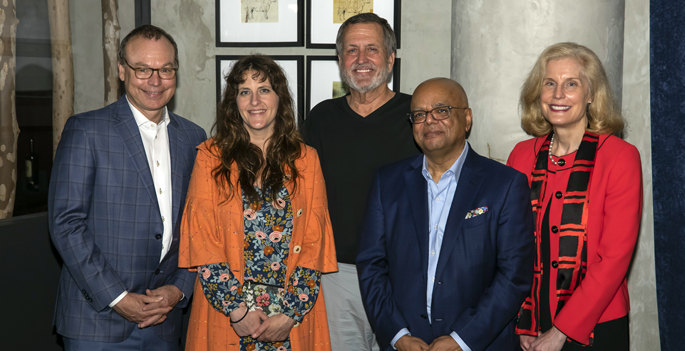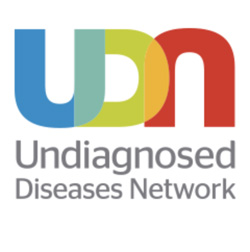Armed with a $7.2 million grant from the National Institutes of Health (NIH) Vanderbilt University Medical Center is one of six medical centers around the country selected to participate in a network to develop effective approaches for diagnosing hard-to-solve medical cases (undiagnosed diseases).
Undiagnosed diseases are conditions that even skilled physicians can’t diagnose despite extensive clinical investigation. They may not be recognized by doctors because they are rarely seen, are previously undescribed or are rare forms of more common diseases.
The NIH estimates that approximately 25-30 million Americans suffer from a rare disorder, often going long periods of time without a diagnosis.
The clinical sites in the Undiagnosed Diseases Network (UDN) will receive $43 million over four years and will contribute local medical expertise and conduct clinical evaluation and scientific investigation in cases that involve patients with prolonged undiagnosed conditions. The six newly awarded sites join a clinical site already established at the NIH in Bethesda, Maryland, that has for the past six years enrolled people with undiagnosed medical conditions from nearly every state, the District of Columbia and seven foreign countries. The NIH program has evaluated hundreds of patients and provided many diagnoses, often using genomic approaches for rare conditions.
Under the current program, physicians can nominate a patient to visit one of the seven UDN sites to try to find a solution for their complicated and undiagnosed problem.
The Vanderbilt UDN clinical site will have emphases on heritable lung diseases in adults and children, heritable and other heart problems including pharmacogenetics, arrhythmias and autonomic disorders in adults, and metabolic and other genetic problems in children.
“The NIH’s goal in this is to discover new diseases,” said John Phillips III, M.D., David T. Karzon Professor of Pediatrics and director of the Division of Medical Genetics and Genomic Medicine, who is co-principal investigator with John Newman, M.D. Elsa S. Hanigan Professor of Pulmonary Medicine. “A lot of these people haven’t been diagnosed, not because they don’t have something, but because nobody has seen what they have before. The demand has outgrown what NIH can offer, and there’s the convenience issue – patients have to come from California to Bethesda. “It’s time to set up a network of clinical sites that will serve that same role, but will be more geographically dispersed.”
Phillips said each clinical site in the UDN will offer “studies that go beyond what is routinely done, “such as whole exome sequencing (sequencing all genes). “The way I look at it, we have an estimated 23,000 genes. We know of diseases that go with just over 4,000 of those genes. That means we have about 19,000 genes that are looking for a disease that no one knows about,” he said.
Newman said Vanderbilt was an ideal choice because of its structure and strengths in bioinformatics, its BioVU program (Vanderbilt’s bank of de-identified DNA samples), the REDCap (Research Electronic Data Capture) developed at Vanderbilt, and the Clinical Research Center where patients will be seen. “We’re very well positioned for this kind of work at Vanderbilt. This is what we do,” he said.
The other clinical site institutions are: Baylor College of Medicine, Houston,; Duke University, Durham, North Carolina; Harvard Teaching Hospitals, Boston; Stanford University, Stanford, Calif., and University of California Los Angeles, and the NIH. The UDN Coordinating Center will be at Harvard Medical School, allowing the network to share systems for data collection and develop common approaches to patient selection, evaluation and diagnosis.
Since 2008, the Undiagnosed Diseases Program at the NIH has enrolled about 600 undiagnosed children and adults in its clinical protocols, and about 100 patients have been diagnosed, two unknown diseases have been discovered and 15 genes were identified that have not previously been associated with any other human disease. A combination of genomic and clinical analyses contributed to the diagnoses.
“We have a great cohort of physician clinicians who we can match to the needs of our patients in the UDN,” Phillips said. “Patients will not have to figure out if they need a pulmonologist or a cardiologist, or both. We’re going to do that for them.”
Along with robust clinical evaluations, genomics will play a central role in the UDN’s mission, said Eric Green, M.D., Ph.D., director of the National Human Genome Research Institute and co-chair of the UDN working group. “Newly developed methods for genome sequencing now provide us amazingly powerful approaches for deciphering the causes of rare undiagnosed conditions,” he said.
By including an additional six clinical sites, the UDN will both draw upon the unique expertise of new clinical research groups and cultivate opportunities for collaboration among a larger group of expert laboratory and clinical investigators. Physicians within the network will collect and share data. They will also benefit from common protocols designed to improve the level of diagnosis and care for patients with undiagnosed diseases.
But Phillips said the UDN is about more than just identifying diseases that haven’t been identified before. “We are interested in unusual things, or trying to explain things. Why has something happened? What is the cause? The ultimate goal is if you understand the cause, then maybe you can do something about it.”
After an initial year to start up and test its operating procedures, each new site is expected to admit about 50 new patients per year by the summer of 2017
Instructions on applying to the UDN on behalf of a patient can be found at rarediseases.info.nih.gov/undiagnosed.
For more information about the UDN, visit http://commonfund.nih.gov/Diseases/index.
Vanderbilt’s UDN clinical site award is supported by NIH grant 1 UO1HG007674-01.
















